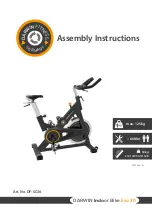
9
TRAINING GUIDELINES
Exercise is one of the most important factors in the overall health of an individual.
Listed among its benefits are:
• Increased capacity for physical work (strength endurance)
• Increased cardiovascular (heart and arteries/veins) and respiratory efficiency
• Decreased risk of coronary heart disease
• Changes in body metabolism, e.g. losing weight
• Delaying the physiological effects of age
• Reduction in stress, increase in self-confidence, etc.
There are several components of physical fitness and each is defined below.
STRENGTH
The capacity of a muscle to exert a force against resistance. Strength contributes to power and speed.
MUSCULAR ENDURANCE
The capacity to exert a force repeatedly over a period of time, e.g. it is the muscular endurance of
your legs to carry you 10 km without stopping.
FLEXIBILITY
The range of motion of your joints. Improving flexibility involves the stretching of muscles and
tendons to maintain or increase suppleness, and it provides increased resistance to muscle injury or
soreness.
CARDIO-RESPIRATORY ENDURANCE
The most essential component of physical fitness. It is the efficient functioning of the heart and
lungs.
AEROBIC FITNESS
Is an exercise of relatively low intensity and long duration, which depends primarily on the aerobic
energy system. Aerobic means "with oxygen", and refers to the use of oxygen in the body's metabolic
or energy-generating process. Many types of exercise are aerobic, and by definition are performed at
moderate levels of intensity for extended periods of time.
ANAEROBIC TRAINING
Is an exercise intense enough to trigger anaerobic metabolism. This means “without oxygen” and
is the output of energy when the oxygen supply is insufficient to meet the body’s long term energy
demands. (For example, a 100 meter sprint.)
Summary of Contents for S3Ti
Page 4: ...4 WARNING LABELS...
Page 36: ...36 TIQUETTES DE MISE EN GARDE...










































